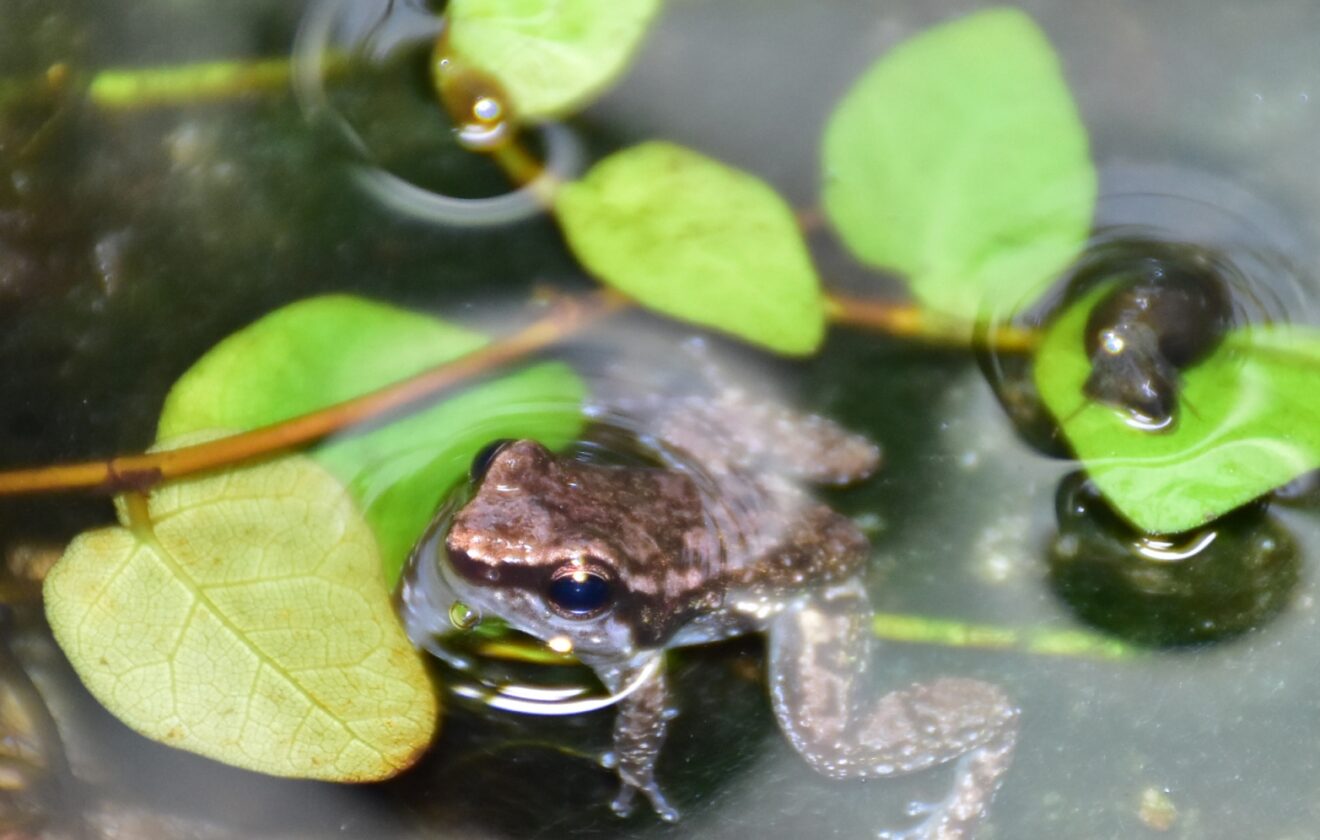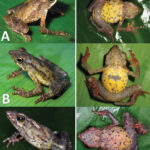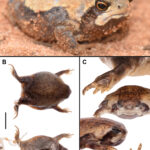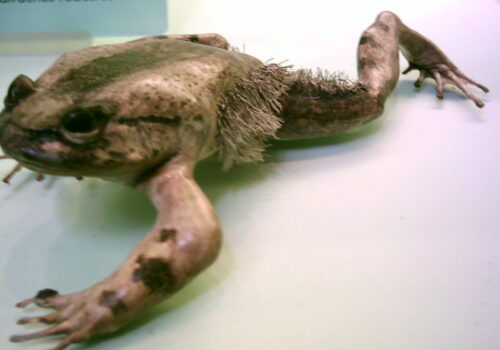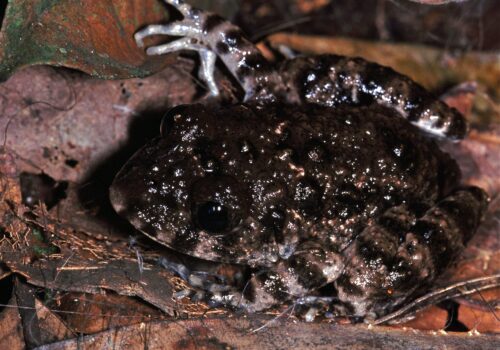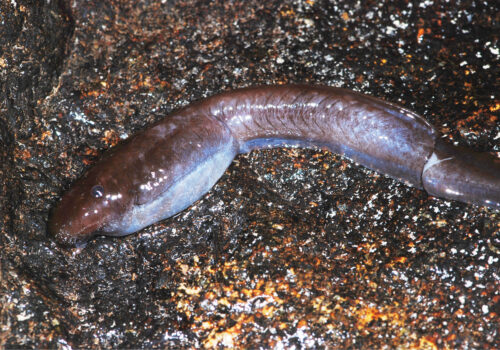- Introduction: The Elusive Jewel of Trinidad's Rainforest
- Taxonomy and Classification
- Natural Habitat: Living Beneath the Shaded Canopies
- Physical Characteristics: Vibrant Displays in Miniature
- Behavior and Life Cycle: Dedicated Parents in the Misty Understory
- Ecological Role: Guardians of the Forest Ecosystem
- Threats and Conservation Status: Standing at the Edge of Vulnerability
- Cultural and Scientific Significance: Trinidad’s Biological Gem
- Conclusion: Preserving the Legacy of Mannophryne olmonae
Introduction: The Elusive Jewel of Trinidad’s Rainforest#
Hidden beneath the lush canopy of Trinidad’s northern mountain rainforests dwells a small, delicate creature whose life unfolds mostly unnoticed by human eyes. Mannophryne olmonae, commonly known as the Bloody Bay Poison Frog or simply Olmonae Frog, is an exquisite amphibian that captivates anyone fortunate enough to encounter it. With its striking colors, remarkable parenting behaviors, and subtle role in maintaining ecological balance, this species represents a perfect blend of mystery and beauty concealed within the tapestry of Trinidad’s rich biodiversity.
Identified scientifically as Mannophryne olmonae, this diminutive frog belongs to the aromatic family of Aromobatidae, characterized by frogs known for their territoriality, unique parental care, and fascinating locomotion. Although the unassuming presence and reclusive habits of this species render it cryptic, those intrigued by its natural history soon realize its incredible story mirrors that of the rainforests it inhabits—fragile, complex, and increasingly vulnerable.
Taxonomy and Classification#
The scientific history of Mannophryne olmonae is one of careful examination and steady discovery. Originally described under the genus Colostethus, the re-classification into the genus Mannophryne has today provided greater insight into its evolutionary identity and its ecological relatives. Belonging to the Aromobatidae family, the Olmonae frog shares genetic lineage and behavioral traits with a handful of closely related species across northern South America and the Lesser Antilles.
This genus, Mannophryne, is characterized by frogs adapted to life in moist habitats near forest streams and running water, a defining trait also embraced by M. olmonae. These frogs exhibit similar morphology and behaviors, yet subtle differences in coloration, mating calls, and habitat preferences have fascinated taxonomists and conservationists alike, reinforcing the importance of precise identification in both field studies and conservation initiatives.
Natural Habitat: Living Beneath the Shaded Canopies#
The verdant forests of the Northern Range of Trinidad provide the perfect sanctuary for Mannophryne olmonae. This frog exemplifies the essence of dependency on its surroundings, requiring dense, humid habitats with gentle brooks and moist leaf litter for both survival and procreation. It can be found primarily at elevations ranging between 300 and 900 meters above sea level, maintaining residence within narrow geographic confines, making its continued existence uniquely intertwined with these delicate ecosystems.
Streams carved gracefully through the rainforest valleys, punctuated by cascading waterfalls and forest pools, supply the necessary microhabitats this species needs to thrive. Here, amid moss-covered stones and decomposing foliage, Mannophryne olmonae lives a cryptic life, hunting for small insects and swiftly hopping from shadow to shadow—an expert of camouflage and concealment within a world defined by lush greenery and trickling water.
Physical Characteristics: Vibrant Displays in Miniature#
Despite measuring no more than 2.5 centimeters in length, the vibrant coloration of Mannophryne olmonae is arresting, even to the casual observer. Its dorsal surface typically varies from shades of rich brown to earth-toned ochers, sometimes speckled or blotched to effectively blend into the leaf litter. Contrasting this camouflaged backdrop, however, are boldly defined yellow or bright-orange markings on their limbs and belly areas, an adaptation linked to predator deterrence and intraspecific signaling.
The delicate yet powerful legs of these frogs are testament to their semi-aquatic lifestyle, aiding them in precise leaps and agile escapes from potential threats. Their skin texture, smooth and damp, is a hallmark of amphibians adapted to high-humidity environments. Particularly intriguing are subtle adaptations of M. olmonae: carefully evolved traits such as cryptic coloration and a degree of toxicity, both instrumental mechanisms allowing it to survive the predatory pressures prevalent within their northern Trinidad rainforest habitat.
Behavior and Life Cycle: Dedicated Parents in the Misty Understory#
Perhaps most astonishing among Mannophryne olmonae‘s behavioral repertoire is the sophisticated approach they take toward reproduction and parental care. Breeding coincides with Trinidad’s rainy season, when the forest resonates with their soft, clicking calls. Males stake out suitable territories close to running water, meticulously selecting secure and moisture-rich locations for egg-laying.
Females lay clusters of eggs enclosed amid damp humus layers or beneath sheltered rocks. Here, in an extraordinary display of paternal devotion, male frogs guard tirelessly over the developing clutch. Upon hatching, the father continues his vital role, carefully ferrying the tiny tadpoles on his back to nearby streams and pools, where botanically-rich waters provide their developing offspring with a controlled and abundant environment rich with microscopic food sources. This remarkable parental care underscores an emotional depth seldom associated with amphibians, highlighting how deeply evolution has sculpted their reproduction to maximize offspring survival.
Ecological Role: Guardians of the Forest Ecosystem#
Mannophryne olmonae occupies an essential, though subtle, ecological niche in Trinidad’s rainforests. As avid insectivores, they regulate populations of arthropods and help maintain the delicate balance of their ecosystem by controlling insect abundances, thereby playing their part in complex food webs.
Conversely, these small yet vital amphibians offer sustenance for predators, including various snakes, birds, small mammals, and larger amphibian species. Their sensitivity to environmental changes positions them as critical bioindicators, signaling when their habitats are compromised by pollution, climate shifts, or habitat degradation. The health and stability of M. olmonae‘s populations are an invaluable gauge for broader ecosystem health and resilience.
Threats and Conservation Status: Standing at the Edge of Vulnerability#
Despite the magical imagery they evoke, Mannophryne olmonae faces significant contemporary threats, as recognized by the International Union for the Conservation of Nature (IUCN), which currently lists them as “Vulnerable”. Forest degradation, illegal deforestation, and changes in rainfall patterns exacerbated by climate change greatly threaten their delicate habitats. Moreover, pollution runoff and the introduction and spread of invasive species further escalate the challenge for these tiny amphibians.
Fortunately, local conservationists and scientists are actively working to protect forest habitats, encourage sustainable land practices, and raise awareness of this extraordinary frog. Dedicated projects, habitat corridors, and environmental education programs seek to safeguard the species’ habitat, aiming to secure a brighter future for Trinidad’s hidden rainforest treasures.
Cultural and Scientific Significance: Trinidad’s Biological Gem#
The cultural significance of this small amphibian extends beyond mere ecological roles. In traditional Caribbean folklore, frogs often symbolize resilience, guardianship, and environmental balance—traits entirely embodied by Mannophryne olmonae. Scientific inquiry into their unique behaviors and secretive life has provided invaluable insights into amphibian biology, behavioral ecology, climate adaptation, and conservation biology.
Researchers keenly study their behavior, reproduction, and ecological interactions not just to document their fascinating life but also to pioneer strategies useful in amphibian conservation globally. The Olmonae frog, despite its subtleness, thus remains an ambassador for Trinidadian rainforests, representing untold biodiversity awaiting understanding and protection.
Conclusion: Preserving the Legacy of Mannophryne olmonae#
Mannophryne olmonae stands as a symbol of nature’s inherent beauty, complexity, and vulnerability. Ensuring their continued survival requires our deeper understanding, active concern, and firm action for habitat conservation. As responsible global citizens and nature enthusiasts, our awareness and advocacy can support ongoing conservation endeavors, encouraging policies and practices beneficial for both the species and the rich ecosystems they inhabit.
You too can play your role—support local conservation initiatives, advocate responsible ecotourism, educate your community, and celebrate the subtle magnificence of these forest guardians. The future survival of the captivating Mannophryne olmonae depends on our collective wisdom, compassion, and stewardship toward these irreplaceable amphibians of Trinidad’s luxuriant rainforests.

